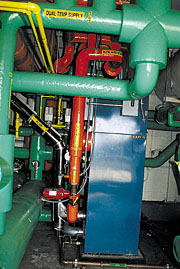
The Census Bureau was also busy last year because its 495,000-sq-ft headquarters at the Suitland Federal Center, Suitland, MD, was scheduled to have its heating system completely replaced. Given that the building and its workers could not be interrupted during that crucial survey-taking time period, those involved with altering the heating system had their jobs cut out for them.
The fast-track project was started in March 2000, and the new heating system had to be up and running no later than September 15, 2000. While there were a few surprises or challenges that arose along the way, the project was finished on time. Once the mercury started to dip last fall, personnel at Bureau headquarters were warm and toasty.
Decentralized Boiler Plant
Before last year, the Census Bureau and four other buildings (totaling about 1.5 million sq ft) in the Suitland Federal Center, were served by a centralized boiler plant. As is the case with many facilities in this area, the underground piping distribution system, which had been in place since around World War II, was in need of repair, and it was determined it would take approximately $10 million to make those repairs. It would also cost several million more to upgrade the boilers at the central plant.The old system provided high-temperature, high-pressure water that was brought through the underground piping system to the buildings. Once the 350?F water reached the building, heat exchangers in the penthouses of the buildings converted it to low-temperature hot water for distribution throughout the building.
The mile-long runs of piping had numerous leaks during heating season start-up, and leaks occurred during the heating season. "The leaks, and to some extent ground water, combined to corrode the metal enclosure of the metal conduit enclosing the insulated piping, wetting the pipe insulation and causing very high underground heat losses," says Charles Gonnermann, project manager, Leach Wallace Associates, Inc. (Baltimore), which designed the new heating system. Potomac Electric Power Company (PEPCO, Washington) acted as performance contractor for the job, while Pepco Energy Services, Inc. (PES) a wholly owned and separately operated subsidiary of PEPCO, managed the project.
Due to the inefficiencies of the existing system, as well as the large capital costs involved to upgrade the central boiler plant, General Services Administration (GSA, Washington) and Pepco Energy Services proposed that the government's money would be better spent by moving to individual, low-temperature, low-pressure steam and hot water systems. This involved providing modular high-efficiency boilers for each of the buildings and placing them in the associated penthouses, which would place the heating source near the location of use.
Another factor in the decision to move to individual boiler rooms in each building was the fact that the existing high-temperature, high-pressure water system meant a licensed engineer had to be in each of the buildings 24 hrs a day, seven days a week. Licensed engineers were also required to be at the boiler plant. That wasn't a particularly attractive arrangement to the government.
"We were having a lot of problems with the existing distribution system," says Steven White, CEM, retrofit team leader for the energy office for GSA "We had a couple miles' worth of direct buried pipe that would have to be excavated and reinstalled. It was a lot less expensive to put boilers in each of the buildings."

Moving Through The Channels
One of the main reasons why it was decided not to upgrade the central boiler plant and the extensive distribution system was that government energy conservation projects are increasingly financed through performance guarantees on energy savings using private sector funds (performance contracts). Upgrading distribution systems typically requires a major investment before it can result in significant energy savings, so what's left is to attack the problem on the source side; therefore, it was determined that relocating the heating source closer to its point of use would result in a lower lifecycle cost for the government.As noted previously, PEPCO played the role of performance contractor in this case. "We performed an engineering study to help the government consider alternative ways of upgrading their heating system to incorporate 21st century technology. A customized energy solution was required," notes David Weiss, president of the Performance Management Group of Pepco Energy Services. Pepco selected Leach Wallace Associates to design the improvements recommended by a Total Life Cycle analysis.
"Energy efficiency and heating system reliability were the motivations for the project," says Gonnermann. "It was necessary to utilize products that were reliable and had a track record of requiring low maintenance."
To that end, 17 modular, gas-fired, Thermal Solutions "Evolution" hot water boilers, each with 2 MMBtuh output, were placed in the penthouse, once the previous heat exchangers were removed.
The existing distribution system operated at 97 dual temperatures, providing heat and cooling as the seasons changed. Isolation valves at the boiler tie-in points were installed early in the project, requiring a chilled water shutdown on a Saturday. "We had to provide temporary cooling for some of the computer spaces over a weekend. We did that with an air conditioning truck, which provides cold air to the steam tunnels in emergency situations. We piped that in through a window to keep their computers cool," says White.
Since the new modular hot water boilers were placed in the penthouse, it was necessary to ensure that the boilers provided the same or lower floor loading to the structure than the existing heat exchangers. In addition, the sound generated by the units was also a consideration, because occupied portions of the building are directly below the penthouse. Jim Hall, sales and service engineer, United Energy Products (Crofton, MD), the company that supplied the new boilers, notes that the Evolution boilers have a rating of 60 dB and are very "sensitive to the worker and the environment."
The existing penthouse was relatively large, but much had to be done, including the removal of the old heat exchangers, to prepare for the new boilers. In addition, pipe had to be cut and welded outside on the roof, because there was no space for it inside. These hot water boilers were spread out across the penthouse in the "spine" of the Census Bureau, which is approximately 250 yards long. (The three-story building has seven wings, each of which is approximately 100 yards long and connected to a central spine. Think of a capital letter "E," only instead of three fingers, there are seven).
Few wide cuts had to be made to the penthouse structure to install the hot water boilers, as their individual 30-in.-sq footprints made them a little easier to get through the doors. However, the doorway had a 20-in. parapet to get over and no head clearance. Some shuffling was required before the boilers could be placed inside.
A crane moved the boilers to the top of the building, thanks to customized rigging devised by the installing contractor, Green Contracting Co. (Baltimore). "They had a steel-welded structure going around the boilers to minimize any rigging damage, and it provided a very efficient means of hoisting them up with a crane. Green Contracting was pretty clever in coming up with this yoke device," says Hall.
It was also not necessary to cut into the building much for combustion purposes. "Rather than having large louvers in the walls to provide combustion air, the Evolution boilers can be installed with sealed combustion, where we have a 6-in. exhaust flue going out the sidewall, and it's made out of stainless steel, and a 6-in. PVC air intake, which also runs through the sidewall to take air in for combustion," notes Frank Smollon Sr., president and owner, United Energy Products.
The boilers communicate via an Alerton (Redmond, WA) building automation system.
Alternative Fuel For Back Up
As one can imagine, the Census Bureau has a fairly large demand for energy. For that reason, natural gas service is provided on an interruptible schedule in order to obtain the best possible price. That interruptible schedule means that a standby substitute for natural gas has to be readily available. In this case, propane was selected, and underground storage tanks hold the propane until it's needed by the boilers."If we are interrupted, we have a propane-to-air mixing system that essentially bleeds air into the propane to bring the Btu content down to the same as natural gas. As far as the boilers are concerned, it's just natural gas," says White. "The natural gas transmission company has to notify us of an interruption, then we have an hour to manually switch over to an alternative fuel."
The boiler will burn natural gas or the propane/air mixture and not even know the difference between the two fuels, says Hall. "Efficiencies will be about the same. Propane actually has more Btu per cubic foot than natural gas, so air is mixed in to give it the same qualities and properties as natural gas."
They haven't had to use the propane system yet, but the heating system worked great last winter on natural gas, reports White. Few problems arose, and Census Bureau personnel were able to count all the occupants of the United States in comfort. ES

Suitland Federal Center Lets The Sun Shine In
The U.S. General Services Administration (GSA) was eager to demonstrate the quiet, clean operability of solar electric power generation near its headquarters in Washington, DC. To build one of the largest photovoltaic arrays in the country, the agency selected a spacious federal site nearby at the Suitland Federal Center in Suitland, MD.After an evaluation of Suitland Federal Center's environmental and economic needs, PEPCO, acting as the general contractor, hired Schott Applied Power Corporation to design and construct one of the largest thin-film photovoltaic arrays in the United States. "I think this shows the flexibility and creative possibilities of energy conservation available today," says David Weiss, president of the Performance Management Group of Pepco Energy Services.
The system consists of an array of 2,800 modules that will convert sunlight into 100 kW of electric power. This solar-generated electricity will provide a portion of the power for the central cooling plant at the Suitland Federal Center.
The project will demonstrate to government agencies and other organizations the short construction time needed in developing solar power stations. In addition, the amorphous silicon technology performs better under high ambient temperatures and costs less to manufacture than conventional crystalline silicon panels. The PV system installation is supported, in part, by funding from the Department of Energy through an award from the Utility PhotoVoltaic Group's (UPVG) "Team-Up" program.ES

